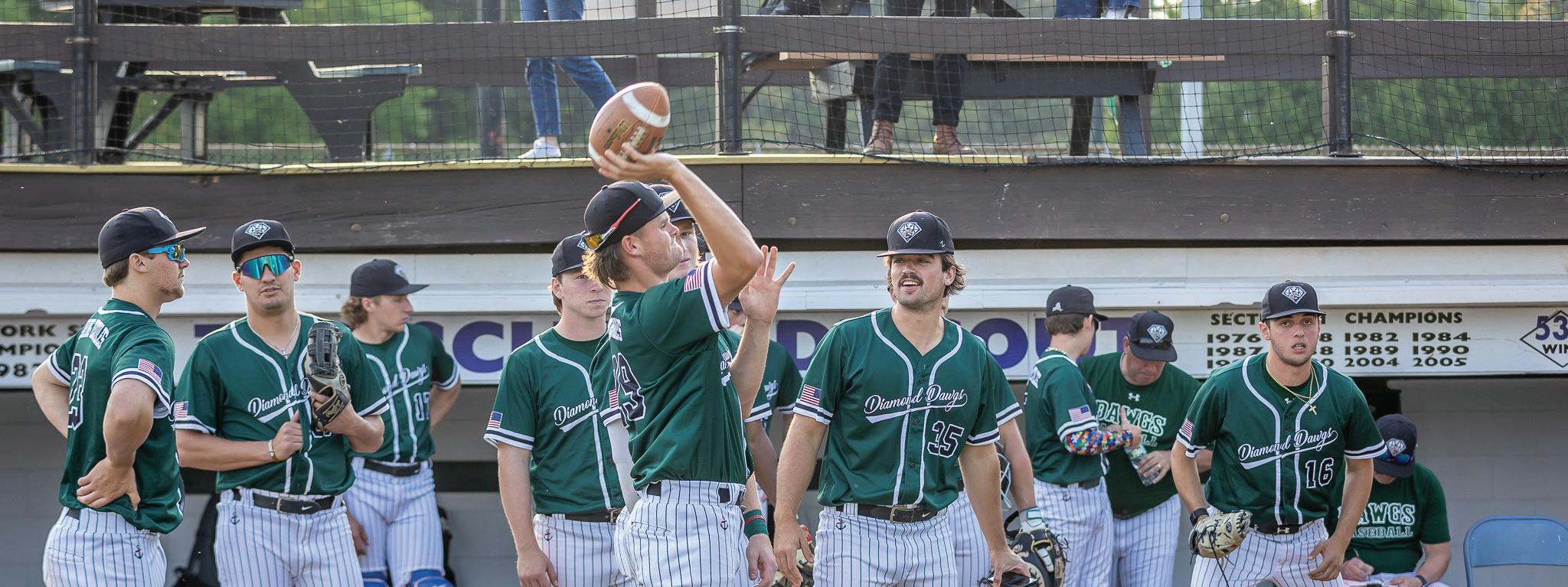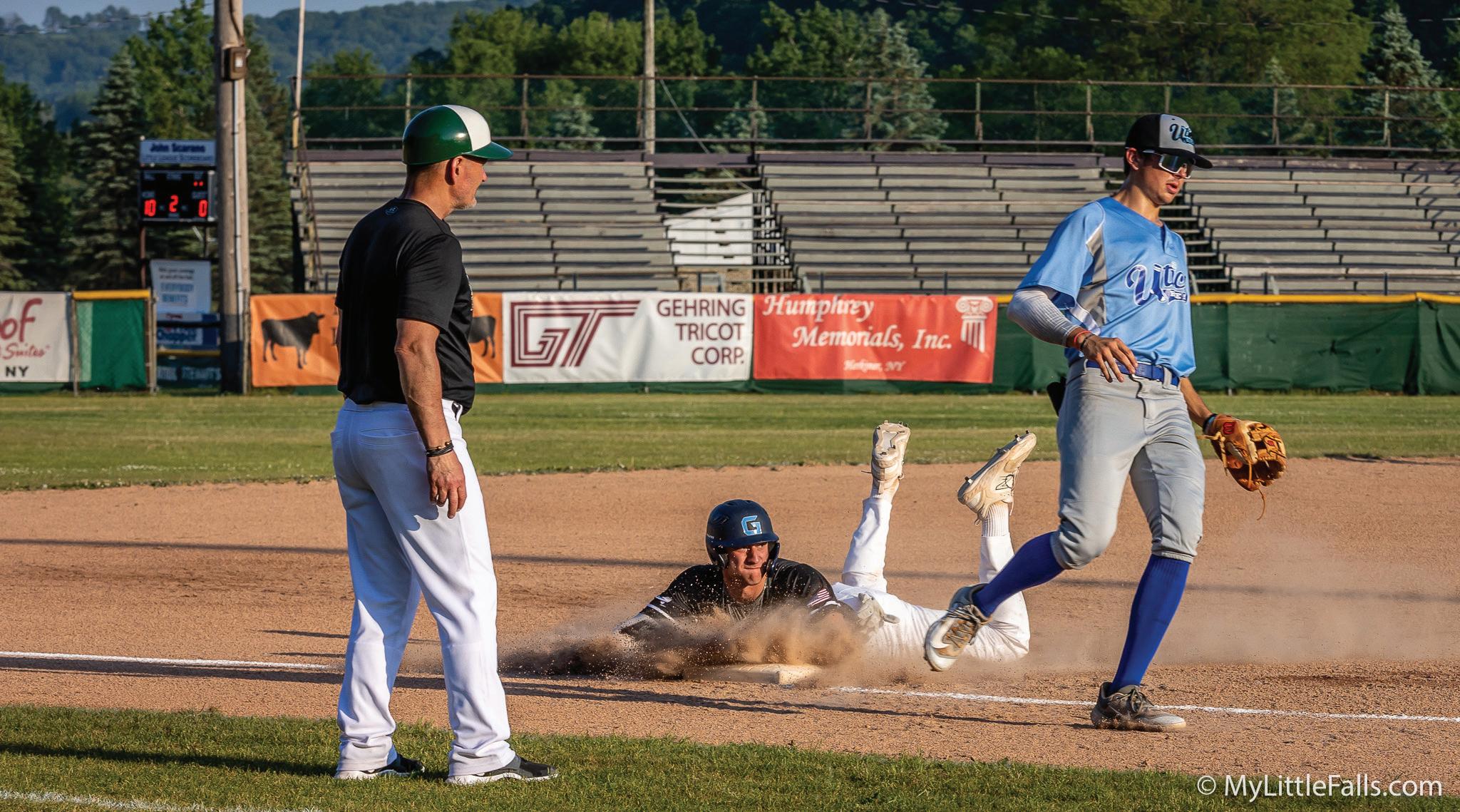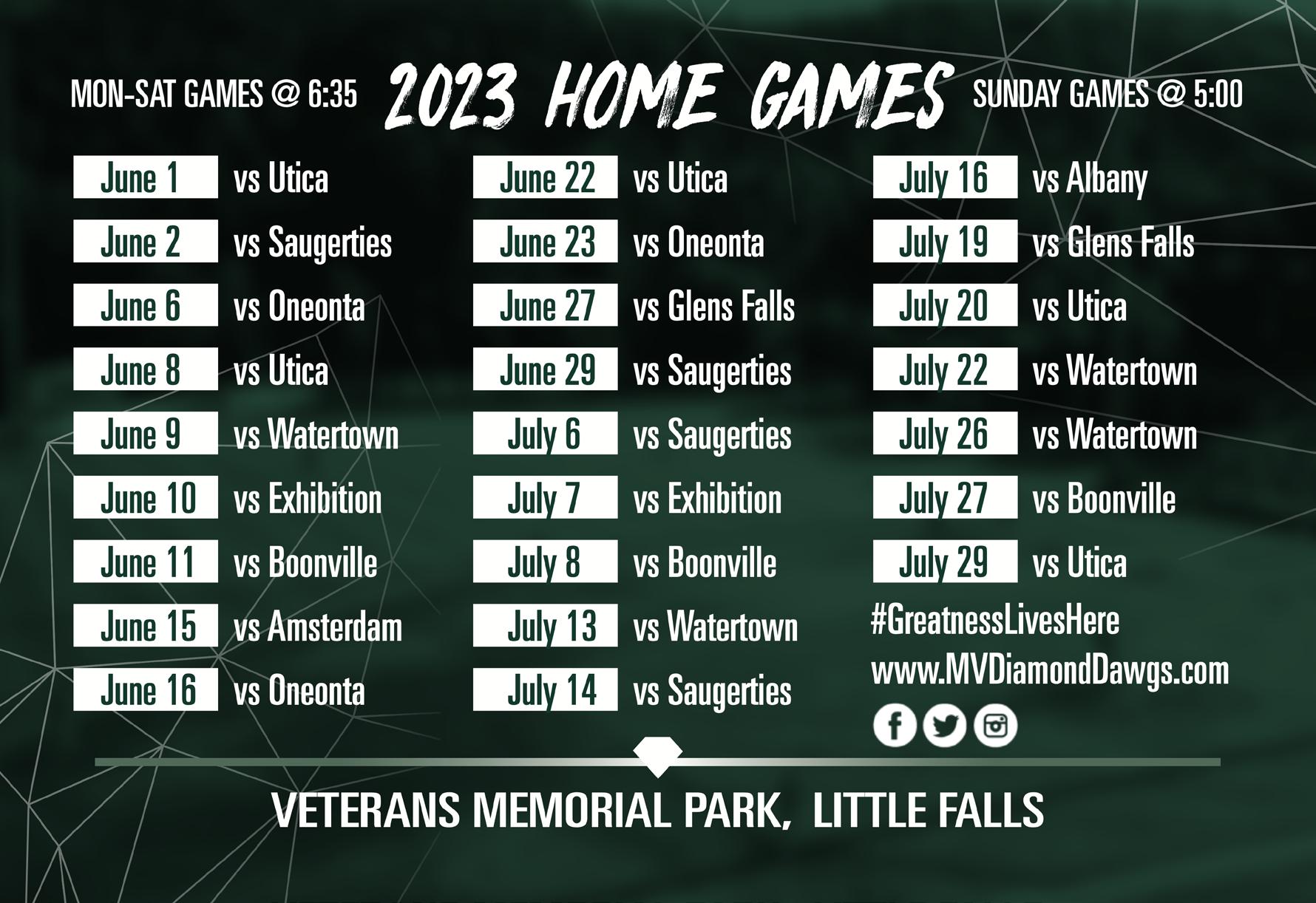
5 minute read
Mohawk Valley Diamond Dawgs provide mid-season update
By Dave Warner
The PGCBL (Perfect Game Collegiate Baseball League)
Advertisement

Mohawk Valley Diamond Dawgs provided a midseason update on the team this week. They are currently 14-5 and in second place in the East Division.
Travis Heiser is the team owner, and his message is simple, “The Diamond Dawgs are deeply committed to providing the best, most affordable, family fun and fan experience in the Mohawk Valley.”
When asked about the team and how he feels they’ve been playing through the first half of the year, he stated, “I think our players have jelled really early this year, which is something that we’ve struggled with in the past.”
“For whatever reason, this year has been something that I haven’t experienced in the sixteen years I’ve been here - having players jell within the first two weeks has been amazing to see. It’s almost like a brotherhood and that these players have been together for many years,” he said.
Heiser said that the team players have bought into the family environment he tries to create, along with the blue-collar atmosphere. “They go out and fight day in and day out. I like that even though we may be down sometimes in games...we never quit, and we keep battling and grinding things out.”
“I think that’s part of the reason we’ve had the early success that we’ve had.”
Coach Steve Luby said, “I’m really pleased with our kids. I think we’ve got an outstanding group of young men that play together and for each other. I think they’ve bonded really well.”
Offensively, he said they’re swinging pretty well and constantly working. “I think our pitching staff has done a great job as far as continuing to grow and finding their role in the rotation. Defensively, for the most part, we play pretty solid defense.”
“The more we compete, the more we’re going to grow,” he said.
He said one of the nice things was that several players had not gotten a lot of innings before coming to the Diamond
Dawgs. “They’ve really grabbed onto our philosophy of being bluecollar, working through things, and putting in the time and effort to improve.”
Coach Luby stated that Heiser does a fantastic job when it comes to recruiting players. “The part that I really like about our kids is that they are coachable. They listen and want to work to make adjustments to improve. That’s really the goal - to send them back to their schools, better than we got them, and they’re doing that.”
After battling Covid for two seasons, the weather has been a factor this year, with abundant rain, smoke from Canada, and cold weather affecting the schedule and gameplay.
“These are things you can’t prepare for. Rain happens every summer, but having the smoke and those kinds of issues have made it challenging for us and every other team in the league,” Heiser said.
He said the real credit goes to the players and coaches who have fought through it.
“Our grounds crew in Little Falls has done a good job preparing the field. I think it has been a team effort from everyone, but the players are here to play.”
Heiser said, “The team just doesn’t quit. We get down, and it would be easy to say let’s just get through the game and go home, but I feel these guys want to win and get better.”
Please See UPDATE Page 19
UPDATE From Page 18 feces. On approximately day three, the nestlings will move to the edge of the nest and “squirt” their waste over the side of the nest. The nestlings grow very quickly and need to be fed constantly. The female will retrieve nectar from flowers; find small insects like aphids and tiny spiders, working continually throughout the daylight hours to feed her hungry brood. Thankfully they grow quickly and are ready to fledge within fourteen to twenty-eight days. At fledging, they will be fully feathered and able to fly and find their own food. They will undoubtedly still beg for food, and she will teach them how and what to eat.
Hummingbirds have a tongue that is long and forked. It is actually two times longer than its beak and is lined with a “hair-like fringe” that is called lamellae. As the hummingbird extends its tongue into a tubular flower where the liquid nectar is found, the tongue laps up the nectar and pulls it back into its beak. Male Rubythroated Hummingbirds live about five years, and the life expectancy of the female is about nine years. Their tiny bodies are between 2.8 inches to 3.5 inches in length for the male and 3.1 inches to 4.3 inches for the female. The male’s weight is estimated at 0.12 ounces, and the female is slightly larger at 0.13 ounces. They are dimorphic, which means they appear different in color and size. The male is an iridescent deeper green than the female and has a ruby-colored gorget (throat patch) which, in certain lighting, can appear black. His chest is a sooty white in color. The female coloring is a limier green iridescent, and she also has a sooty white breast but no gorget. They both have tiny feet and even though they are most often seen flying or hovering, they can perch on a twig or on the provided perch of a hummingbird feeder. In winter, they molt their worn feathers and replace them with new ones. They can often be observed on a twig preening their feathers using their feet as “combs” to scratch their neck or head.
Some of our native wildflowers that are preferred by the hummingbirds are columbine (Aquilegia canadensis) in the spring and both red cardinal flower (Lobelia cardinalis) and jewelweed/ spotted touch-me-not (Impatiens capensis) in the fall. Hummingbirds are instrumental in pollinating all three of these flowers because of their long beak and tongues. It becomes a symbiotic relationship for both, providing food for one and continuation of the species for the other.
Other interesting facts are that the males will depart for their winter habitat about a month before the females and the fledglings. Each species of hummingbird have a unique “humming sound” in flight due to the number of wing beats per species. The ruby-throated hummingbird in flight beats its wings fifty-three beats per second. Unfortunately, hummingbirds occasionally fall prey to predators such as sharp-shinned hawks and other small raptors. Blue jays and crows will sometimes eat the nestlings, and house cats have also been known to prey on hummingbirds. On a happier note, they always seem to bring us great joy. I sincerely thank my dear neighbors and close friends for giving me an opportunity to photograph the hummingbird nest and nestlings which appear in this column. A joy that is shared is a joy made double… Thank you so much.
He said the players arrive early to practice daily, even if they’re not in the night’s lineup. “When their number is called, they’re ready to go.”
Heiser said the one thing they need to work on is not letting large leads slip away. “Even when we win games, and we’ve been up big, we’ve had teams come back on us. When you have a team down and out, you really need to put the hammer down and put them out of the game without question.”
Luby said, “We haven’t seen a couple of teams yet. I know Albany’s pretty good, Saugerties and Utica are always good, so I think that just us coming to play, regardless of who shows up, is the key. Us playing our game. If we do that and take care of our business, we will find ourselves in the hunt at the end of the season.”



The coach also complemented Tyler Roper for doing a fantastic job with the kids. “Without him, we wouldn’t be where we are.”
“I’m really excited to see where the season ends,” Heiser finished.








